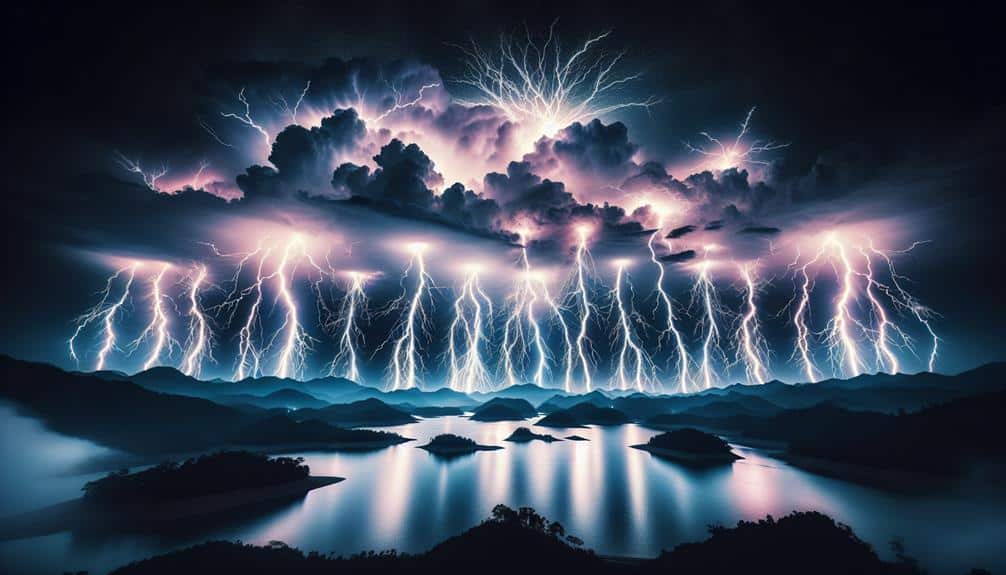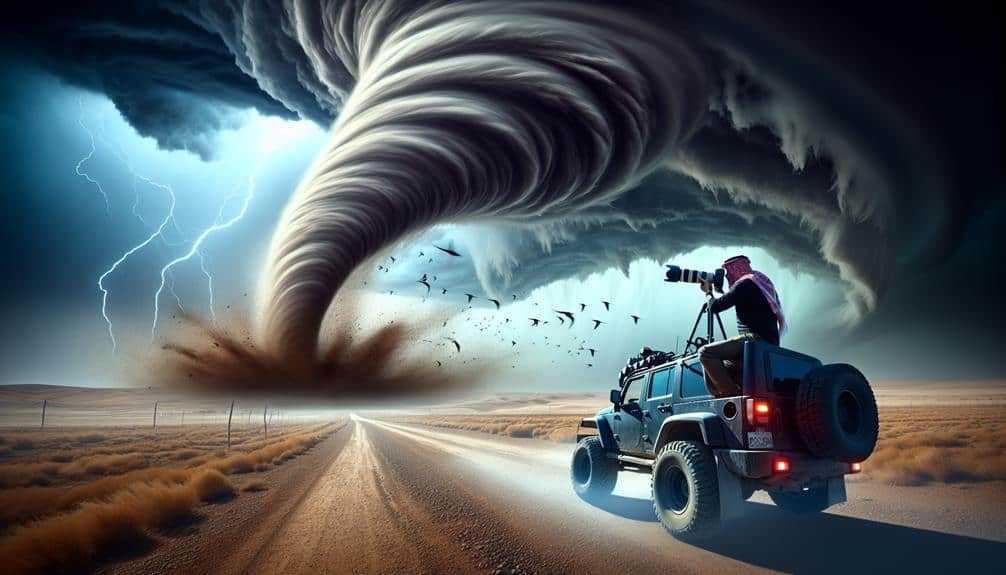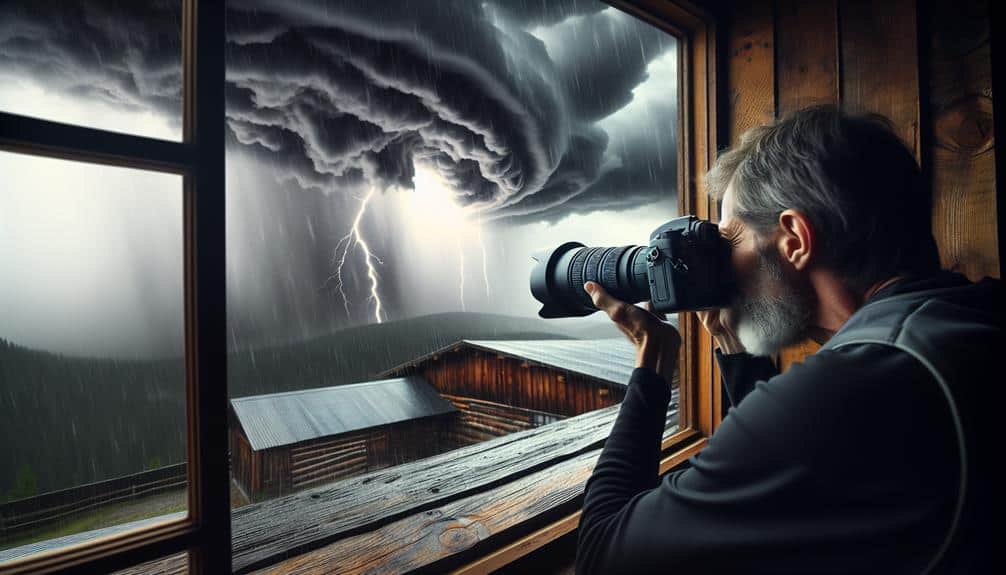Selecting the appropriate vantage points is pivotal in storm photography because they improve our capacity to frame the storm's dramatic elements effectively. Elevated positions provide wider views of the storm's structure and movement, while distinctive angles can emphasize the interaction between the storm and the landscape. A well-chosen vantage point guarantees we capture the storm's dynamic lighting and steer clear of obstructions, all while prioritizing safety. Utilizing tools like radar apps, we can accurately position ourselves to seize the moment without compromising safety. Exploring strategic vantage points will unveil more methods to enhance our storm photography skills.
Key Points
- Vantage points provide unique perspectives and angles to capture the storm's structure and movement.
- Higher vantage points offer a broader view, showcasing the storm's development and expanse.
- Different vantage points highlight the storm against various backdrops, adding visual interest.
- Strategic vantage points enhance the dramatic effect and composition of storm photographs.
Enhancing Composition
When enhancing composition in storm photography, we should focus on the rule of thirds to create a balanced and engaging image.
By dividing our frame into a 3×3 grid, we can position key elements—such as a striking lightning bolt or a dramatic cloud formation—along these lines or at their intersections. This technique not only lends balance to our photos but also maximizes visual interest.
To add depth perception to our storm images, incorporating foreground elements like trees or buildings can be highly effective.
These elements not only provide a sense of scale but also draw viewers into the scene, making them feel as though they're right there in the midst of the storm.
We must remember to stay safe while capturing these images. It's crucial to be aware of our surroundings and avoid areas prone to lightning strikes or flooding.
A safe vantage point can still offer amazing opportunities to capture stunning compositions.
In storm photography, our artistic vision is key. By combining technical expertise with creative composition techniques, we can produce images that capture the raw power and beauty of a storm, all while ensuring we remain safe and free to explore our passion.
Capturing Dramatic Lighting
How can we harness the dramatic lighting of a storm to elevate our photography to stunning heights? By strategically selecting our vantage points, we can capture the storm's natural theatrics in ways that showcase unique angles and striking contrasts.
Storm lighting, with its intense bursts and sudden fluctuations, provides an unparalleled opportunity to play with dynamic shadows and vibrant colors. When we position ourselves thoughtfully, we can frame these elements to create images that are both technically impressive and artistically enthralling.
To capture the essence of dramatic lighting, we need to be mindful of the storm's evolving nature. The key lies in anticipating where the lightning might strike or where the darkest clouds will form. By doing so, we can align our shots to highlight the interplay between light and shadow, enhancing the depth and mood of our photographs. Utilizing tools like graduated neutral density filters can help us balance the exposure, ensuring that the sky's brilliance doesn't overshadow the landscape's details.
Let's embrace the storm's raw power and unpredictability. By combining technical expertise with an adventurous spirit, we can transform fleeting moments of dramatic lighting into lasting visual masterpieces.
Safety Considerations
As we embrace the storm's raw power to create visual masterpieces, we must prioritize our safety to guarantee that our pursuit of stunning photography doesn't come at the expense of our well-being. First and foremost, equipment preparation is critical. Ensuring that our gear is weather-sealed and securely packed can prevent damage and allow us to focus on capturing the storm's beauty. Carrying waterproof covers and sturdy tripods can make all the difference in harsh conditions.
Equally important is having a well-thought-out emergency plan. Knowing the local weather patterns, escape routes, and nearest shelters can provide an invaluable safety net. We should always inform someone of our location and expected return time, ensuring that help can be dispatched if needed.
While artistic vision drives us toward the perfect shot, safety awareness demands we respect the storm's unpredictability. Real-time weather apps and portable radios can keep us updated on storm developments, giving us the foresight to retreat when necessary.
Elevation and Perspective
Selecting the appropriate vantage point significantly enhances our ability to capture storm photography that's both visually captivating and technically precise. Height and viewpoint are crucial components that enable us to achieve this. By exploring elevated positions, we acquire a broader perspective of the storm's formation, providing distinct viewpoints that set our photos apart.
Elevated locations have the potential to turn an apparently ordinary storm into a stunning display, capturing dynamic images that depict the unprocessed power and beauty of nature.
Aerial perspectives, whether from elevated terrains or drones, introduce an additional layer of dramatic impact to our photographs. From heightened vantage points, we can capture the expansive sweep of a storm front, the intricate designs of lightning, and the contrasting hues of the sky. These viewpoints offer a sense of magnitude and intensity that are frequently absent in ground-level shots.
Nevertheless, we must harmonize our artistic vision with safety consciousness. Elevated sites may pose their own risks, such as unstable ground or exposure to lightning. Always prioritize safety by selecting secure elevations and utilizing remote equipment when required.
Avoiding Obstructions
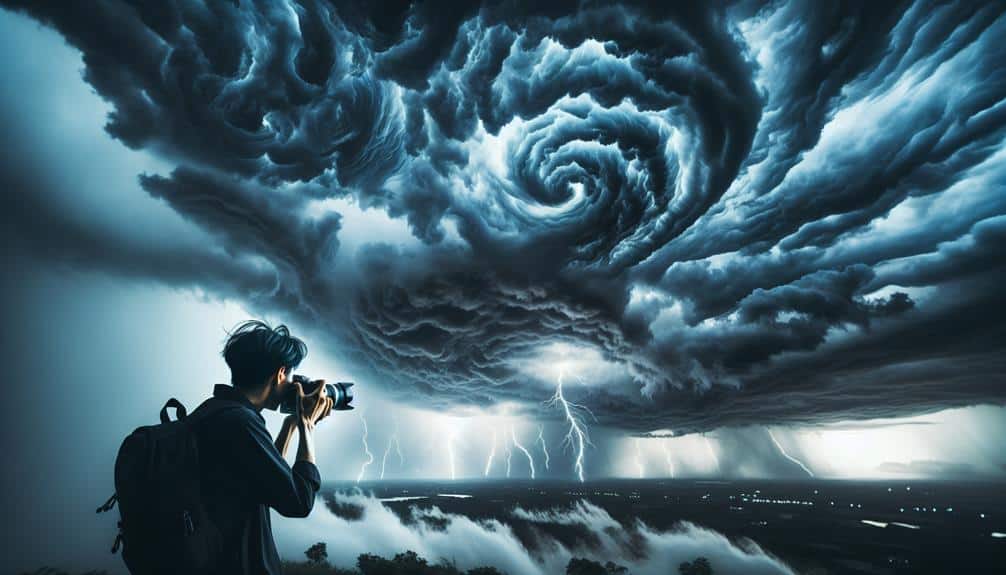
Securing our storm photography to remain free from obstructions is crucial for capturing clear and impactful images. To accomplish this, we need to prioritize strategic positioning. This involves identifying spots that offer a clear view of the storm while keeping any potential visual barriers out of our frame. By doing so, we guarantee our photos have unimpeded sightlines, allowing the raw power and beauty of the storm to take center stage.
When scouting locations, we should concentrate on areas that provide unique angles. This may involve being innovative with our positioning, such as locating elevated spots or open fields. However, safety should always be our main concern. We must steer clear of precarious vantage points that could endanger us, especially during severe weather conditions.
Furthermore, we should always be aware of the elements around us. Trees, buildings, and even power lines can inadvertently intrude into our shots, detracting from the overall composition. By consciously selecting our locations with these factors in mind, we can effectively avoid impediments. This method not only enhances the visual impact of our storm photography but also guarantees we can work safely and efficiently, capturing the majestic fury of nature in its purest form.
Utilizing Natural Landmarks
While framing our storm photography, leveraging natural landmarks can add depth and context to our images. By incorporating elements like mountains, trees, or rivers, we create a sense of scale that highlights the storm's grandeur.
Using unique angles can transform an ordinary shot into a captivating visual narrative. Think about how a lone tree silhouetted against an ominous sky provides a stark contrast that amplifies the storm's intensity.
Our choice of natural landmarks also opens up opportunities for creative framing. Positioning ourselves so that a winding river leads the viewer's eye toward the storm can add layers of intrigue and movement to our photographs. Or, imagine capturing the reflection of lightning in a calm lake; it's these thoughtful compositions that elevate our work from simple documentation to evocative artistry.
Safety remains paramount. As we seek out these compelling vantage points, let's make sure we're not putting ourselves in harm's way. Maintaining a safe distance while capturing these powerful forces of nature is vital.
With careful planning and a keen eye for detail, we can use natural landmarks to not only enhance our storm photography but also to tell a story that resonates deeply with our audience.
Timing the Shot
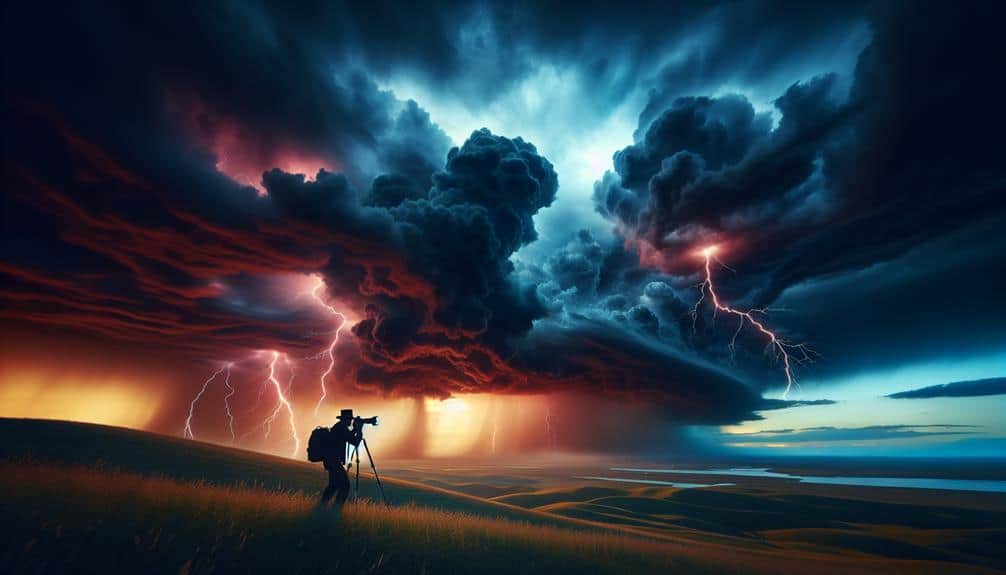
Capturing the perfect storm shot hinges on our ability to anticipate and understand the storm's movements, ensuring we're ready at the vital moment. Timing is everything—missing the perfect moment can mean the difference between a dramatic, awe-inspiring image and a missed opportunity.
We must be finely attuned to weather patterns, using tools like radar apps and satellite imagery to predict the storm's trajectory.
Ideal conditions often include the 'golden hour' just before sunset or after sunrise, when the light is soft and diffused. However, storms have a will of their own, and we need to adapt quickly to changing light and weather conditions.
We should always keep our cameras at the ready, with settings pre-adjusted for swift changes in light and movement.
Safety is paramount. While chasing the perfect moment, we must maintain a safe distance from the storm's path. It's essential to have an escape route planned and to be aware of the storm's development to avoid getting caught in hazardous conditions.
Frequently Asked Questions
What Equipment Is Essential for Storm Photography?
Sure, we all love risking it all for a great shot. Essential camera gear includes a sturdy tripod, weather-sealed camera, and wide-angle lens. Mastering lighting techniques while ensuring safety lets us capture nature's fury from a safe distance.
How Can I Predict the Best Time for Storm Photography?
We can predict the best time for storm photography by analyzing weather patterns and using advanced forecasting tools. Good lighting conditions are important, so timing our shoots around golden hours guarantees dramatic and safe captures.
What Are the Best Post-Processing Techniques for Storm Photos?
Think of post-processing as polishing a gem; we use color correction, cropping for composition, noise reduction, and sharpening to enhance storm photos. These techniques capture the storm's raw power while ensuring our artistic vision shines through.
How Do I Protect My Camera Gear During a Storm?
We prioritize camera protection by using waterproofing solutions and organizing our gear efficiently. Emergency shelters offer refuge during severe conditions. This approach guarantees our equipment stays safe, allowing us to capture stormy landscapes and embrace our creative freedom.
What Settings Should I Use for Capturing Lightning?
For capturing lightning, we should use a small aperture (f/8-f/16) and a long shutter speed (10-30 seconds). Camera angles and composition are key; guarantee safety by keeping distance and avoiding open areas.
